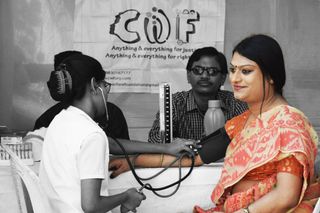
What a Transgender‑Friendly Health Care System Would Look Like
A trans doctor describes how to eliminate the stigma and ill-treatment transgender people currently face from health care professionals.

Health care for transgender people in India is fraught with stigma and misinformation. Transgender bodies are considered deviant, which in turn peddles misinformation around their bodies and their health care. The main vectors of this lack of knowledge are unskilled medical professionals, who have been taught on the male/female binary and often misgender and ill-treat trans bodies they are not familiar with. It doesn’t help that both — trans patients and their doctors — exist within an unaffordable, ill-equipped health care system. While government hospitals offer cheap health care, they’re often not trained on how to deal with transgender people; the only transgender-focused care government hospitals provide is for sexual health and HIV prevention. Transgender people who seek sex reassignment surgeries (SRS) are often forced to consult with private medical providers, where care might be of higher quality, but the process is costly. Stack on top the fact that SRS is considered a cosmetic surgery, which renders it outside the purview of insurance policies that can subsidize costs.
Access to more holistic health care for transgender people is gradually being considered by medical establishments. For instance, clinics that offer affordable health care exclusively to transgender people have been cropping up in Kerala, Tamil Nadu. But, most of the country’s hospitals lack an organized standard of care for trans patients, according to Dr. Sameera Jahagirdar, a critical care specialist at the Mahatma Gandhi Medical College and Research Institute (MGMCRI) in Pondicherry.
As a trans, non-binary person who is a doctor, Jahagirdar has firsthand experience of how medical institutions are ill-equipped to provide care for trans people — 10 years ago, when she decided to transition, she realized there were few doctors in India who were skilled and confident enough to undertake the procedure. While some admitted they didn’t know how to perform the surgeries, one doctor simply declined to help her. For eight years, Dr. Jahagirdar underwent hormone therapy, during which time she made workplace adjustments and came out to her bosses, settled into relationships and became familiar with the physical changes in her body. All the while, the doctor who had agreed to perform her surgery was obtaining more experience so they could finally help Dr. Jahagirdar complete her transition.
“If a transgender client comes to the institution, how should the hospital take care of them?”
While she was struggling to find medical resources for herself, MGMCRI, where Dr. Jahagirdar worked was also undergoing changes: in 2014, the institute was offering only HIV prevention care to transgender people. Then, a surgeon joined who claimed he knew how to perform sex-reassignment surgery, but turned out to be unskilled, Dr. Jahagirdar said. At that point, the institute didn’t require its patients to fill out paperwork related to consent, which caused legal trouble when the parents of a person older than 18 who had undergone transition surgery at the institute accused its medical professionals of forcibly performing surgery on their child. Dr. Jahagirdar said hospital administrators at the time “were shaken” after the accusation, and proceeded to discontinue all trans-related health care programs — until she came out to her boss, and was given the freedom to devise her own health care protocol for trans people.
“If a transgender client comes to the institution, how should the hospital take care of them?” Dr. Jahagirdar posed the question to herself and got to work.
The first step is documenting consent, she said. Being trans only requires self-identification, which, in the health care system, means a trans person wanting sex-reassignment surgery needs to sign an affidavit self-declaring themselves as trans and present the document in front of a magistrate. At MGMCRI, Dr. Jahagirdar said nobody knew how to draft the form, so she referred to already-existing samples and devised one most suited to her workplace. Before, “there was no evidence of self-declaration of gender and the hospital had no evidence that the client had declared they were transgender,” she said. Now, “a client comes, signs the affidavit, you’re happy you have evidence.”
Related on The Swaddle:
Feminism That Excludes Trans Women is Bigoted, Not Radical
Obstacles for a trans person seeking medical help start right from the front desk, Dr. Jahagridar said — the process to obtain medical records and fill forms out in order to see a doctor involve noting down one’s gender; these forms usually don’t have the option for a third gender. Even if the paper version does, when these records get entered into a digital format, a similar problem arises. If a receptionist behind the desk is filling out a form, it’s possible they will assume your gender based on the way you look, which might not be how you identify, Dr. Jahagirdar says. At her institute, the entry on the form has now been changed from “sex” to “gender,” which has allowed Dr. Jahagirdar to enforce a more inclusive process of obtaining medical records from a trans patient, she said.
Another policy she implemented involved sensitization of doctors, along with forming a fully-functional “gender care team” dedicated to making sure trans patients get the care they need. “When trans people were walking around in the hospital, they would sit down in the [outpatient clinic] and other people used to ask us ‘how can we sit beside such people?’ or ‘how can you treat people like them, here?’ Now, doctors and nurses make sure those who object to transgender people’s presence know the clinic is trans-friendly, and if they have a problem, they will have to adjust,” Dr. Jahagirdar said.
Dr. Jahagirdar became the first person to take advantage of the structured, organized standard of care protocol she had implemented; during this process, she finally found surgeons who came to her institution and helped her transition. “It was an opportunity for me to educate every corner of the hospital. From the time I got admitted in the ward, to when I got rolled into the operation theater, to how the staff nurses spoke to me, to how I received post-operative care. I became like a walking example.”
“It was an opportunity for me to educate every corner of the hospital.”
After the implementation of the protocol, “the hospital admins did not have a fear in their minds of anybody suing or complaining against them. Even if some legal issues were to happen, they were comfortable that they had set a standard of care,” Dr. Jahagirdar said. “The doctors and nurses came to know how we should tackle the trans clients. Trans clients knew what all is going to happen and what stages they are going to be taken through.” Now, the institute offers robust health care options for transgender people, from sex-reassignment surgeries for all transgender people, to hormone therapy, sexual health facilities, and other physical health options, she said.
This, however, could only happen at a private institution — unfortunately, where cost is a major deterrent, she added; it’s a reality quite impossible to realize in a government facility. A widespread, effective HIV screening and intervention program has already been implemented in government hospitals across the country, after India’s National AIDS Control Organization (NACO) recognized transgender people as a “core, high-risk group” to contract HIV. But when trans people go to get tested for HIV at these institutions, they’re often faced with hostile behavior from medical professionals who hold prejudiced views of transgender people as sexually promiscuous, Amrita Sarkar, a trans woman and trans rights activist, with advocacy organization, Solidarity and Action Against the HIV Infection in India (SAATHII), said. Many transgender people opt to engage in sex work for a steady income, which in turn also helps them consider SRS in the long term; in the meantime, they are often forced to engage in unsafe sex without protection, which puts them at risk for HIV infections, Sarkar added.
Related on The Swaddle:
Lok Sabha Passes Trans Bill That Robs The Community of Their Rights
After the 2014 Supreme Court NALSA judgment — which allowed transgender people to identify as male, female or a third gender irrespective of medical sex reassignment, and promised them quotas in educational and professional spaces — little has changed for trans people on the ground, especially in health care. Despite government campaigns, doctors still lack awareness about the physical anatomy of the transgender body — which has led to repeated, harmful cases of misgendering trans people and putting them in the wrong wards in hospitals, Sarkar said. In June 2014, reports showed a trans person died after an accident, because of a delay in treatment caused by the doctors treating them who did not know whether to put them in a male or female ward.
For people undergoing transitions, there are hardly any government hospitals that offer medical services. Private operations cost approximately 3 to 4 lakhs, Sarkar said. “It’s not easy for the community people. Sometimes they have to go for alternative options, like castration process, which is not approved; this leads to a lot of other health problems.”
“Your ovary is working fine, then why do you want to be a man?”
This observation underscores that trans health — in the little that it is discussed — is often focused on the health of trans women. Trans men face health care with even more stigma, says Hemba Oinam, 41, also affiliated with SAATHII. As a trans man, Oinam says his interactions with the medical community have discouraged him from seeking medical help. Even if he goes in to get checked for stomach pain or a headache, he’s often met with questions such as “are you a man or a woman?” and “do you have stomach pain because you have many sexual relations?” Most visits to the doctor are often accompanied by gesturing, pointing and laughing, which embarrasses him, he adds. As a trans man, especially, he’s often met with “your ovary is working fine, then why do you want to be a man?”
Oinam says he often sends his family members to get medicines for him, since interacting with medical professionals is too distressing. “When I have to go, I write down my gender as female. For the time I’m in the hospital, I don’t even write trans man. They will accept me as female; otherwise, they might not bother.” Oinam is currently researching sex-reassignment surgery for himself, and hoping to find a doctor who is willing to perform the surgery — but the cost is again an issue for him. He needs the government to subsidize the surgery expenses, he says. “I hope they know how to treat me; I hope they treat me as a man.”
At the end of the day, in order for transgender people to feel comfortable accessing health care in India, there needs to be an overhaul at all levels of the system — as discrimination exists at all of those levels. “It’s a combination of problems — no acceptance of trans bodies because there is no knowledge of trans bodies, no education. Therefore, there is no infrastructure that supports transgender people,” Sarkar says. “Acceptance can only come at a later stage, when the health care service is there. But it’s not.”
Rajvi Desai is The Swaddle's Culture Editor. After graduating from NYU as a Journalism and Politics major, she covered breaking news and politics in New York City, and dabbled in design and entertainment journalism. Back in the homeland, she's interested in tackling beauty, sports, politics and human rights in her gender-focused writing, while also co-managing The Swaddle Team's podcast, Respectfully Disagree.
Related


On Screen, Women in Leadership Roles Are Four Times as Likely as Men to Be Shown Nude, Finds New Report
